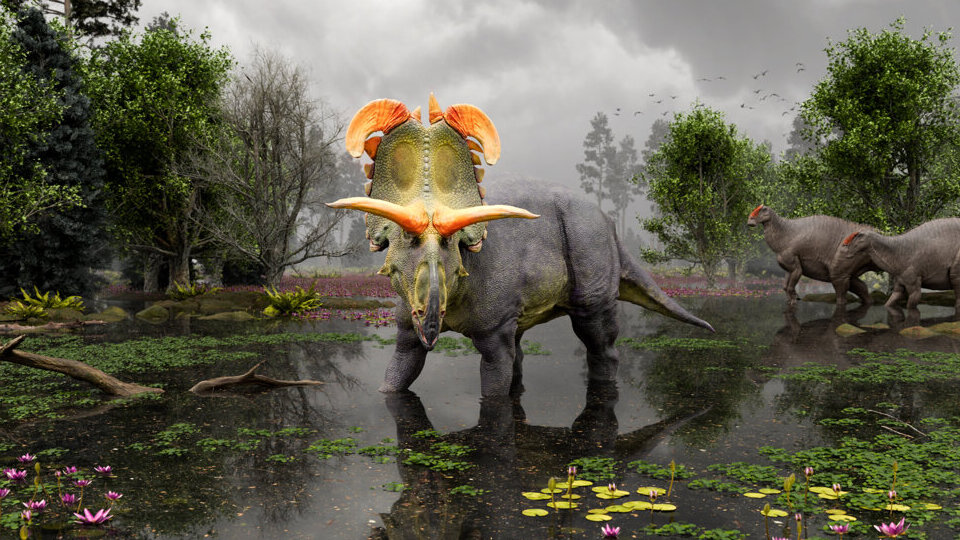In a groundbreaking discovery that has captivated paleontology enthusiasts, researchers have unveiled a new species of dinosaur named Lokiceratops rangiformis. This colossal creature, described as the “largest and most ornate” of its kind, offers a fascinating glimpse into the ancient world of horned dinosaurs known as ceratopsids. Here’s a comprehensive exploration of this remarkable find:
Discovery and Fossil Details
Lokiceratops was unearthed in the badlands of northern Montana, near the U.S.-Canada border, specifically in Kennedy Coulee on private land. The discovery, including a skull and partial skeleton, was meticulously detailed in a study published in the journal PeerJ. This new species belongs to the Late Cretaceous period, approximately 78 million years ago, thriving in the swamps and flood plains of present-day Montana.
Physical Characteristics
This herbivorous giant measured an impressive 22 feet in length and weighed around 11,000 pounds, making it the largest herbivore in its ecosystem during its time. What sets Lokiceratops apart are its exceptionally elaborate horns and frill adornments. Unlike its well-known cousin Triceratops, Lokiceratops lacks a nose horn but boasts an array of horns, including two large and asymmetrical horns on each side of its frill’s midpoint. Additionally, a prominent spike in the center of the frill and more than 20 additional horns along its edge contribute to its distinctive appearance.
Name and Significance
The name “Lokiceratops” derives from the Norse God Loki, reflecting the dinosaur’s horned visage akin to the mischievous deity. “Rangiformis,” on the other hand, refers to its horn arrangement resembling that of a caribou. This nomenclature underscores the cultural and natural inspirations behind the naming process, highlighting the dinosaur’s unique characteristics in both mythological and biological contexts.
Scientific Impact and Study
Dr. Joseph Sertich, a prominent paleontologist and co-lead author of the study, expressed enthusiasm about Lokiceratops, emphasizing its unparalleled horn configurations and frill adornments. The comprehensive study involved painstaking preparation of the fossils, which were cleaned, restored, and assembled in Utah. This meticulous process enabled researchers to reconstruct the dinosaur’s skeletal anatomy and better understand its ecological role and evolutionary adaptations.
Comparative Analysis and Evolutionary Insights
In the realm of ceratopsids, Lokiceratops stands out not only for its size but also for its elaborate cranial ornamentation. The discovery sheds light on the diverse adaptations within the ceratopsid family, offering insights into how these dinosaurs evolved and diversified during the Late Cretaceous period. Comparative studies with other horned dinosaurs provide valuable clues about ecological niches, behavioral patterns, and evolutionary pressures shaping their development over millions of years.
Public Interest and Educational Value
Beyond scientific circles, the unveiling of Lokiceratops has sparked public interest, underscoring the enduring fascination with dinosaurs and their prehistoric habitats. Museums and educational institutions play a crucial role in disseminating knowledge about such discoveries, engaging audiences of all ages in the wonders of paleontology and natural history.
The discovery of Lokiceratops rangiformis represents a significant milestone in paleontology, enriching our understanding of ancient ecosystems and the diversity of life that once thrived on Earth. As researchers continue to study and interpret the fossil record, each new discovery like Lokiceratops contributes to the mosaic of evolutionary history, revealing the extraordinary adaptations and forms of life that shaped our planet millions of years ago.
Lokiceratops exemplifies the ongoing quest to uncover the mysteries of the past, bridging scientific inquiry with public imagination and appreciation for Earth’s deep history.
